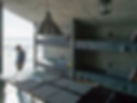Beyond imagination, the infinite possibilities of modular housing
- kaywang6
- Jan 8, 2023
- 3 min read
The container Modular design brings the building back to a simpler way of building, through the industrial production of parts and the on-site assembly of prefabricated modules to achieve low-carbon construction of the building, this ensures that these materials can be recycled after the building has been demolished, allowing people to build their own homes easily and quickly. Building modularization is the innovation of architectural design and construction technology.

These units, built with special new energy-saving materials, are connected in many ways, completely subverting the traditional housing construction and non-circular model, can be simple, can be retro, it is habitable, entertaining and can be used for special purposes. Easy to transport, install, demolition, reuse; each unit can be a regular rectangle, can be irregular polygon, spliced together to show different shapes and structures, resulting in different styles of architectural aesthetics.
Today, let's take a look at those innovative and bold modular housing bar!
Flying Nest: Mobile Hotel
Accorhotels, the French Hotel Group, has been experimenting with a nomadic concept called the Flying NESTSTSTO: Let the hotel follow the customer!

The Flying Nest is a portable hotel that can be placed at any attraction, whether it is at the foot of a mountain, on a beach, or at a sporting event or festival.

Designed by Ora Ito for the hotel, the flying nest uses old shipping containers to create a mobile living space that feels like a cozy log cabin.

Each room is 12 square meters, with a living area, private bathroom and large French windows. The rooms have an open-plan Terrace, amazing views from the bed, and a natural setting for the flying nest hotel, provide a high standard of quality space experience while ensuring recovery and transportation.

In addition, guests are only required to ski, swim or wear a tuxedo to a party, depending on the location of the hotel.
Snow Mountain Hut, Dubldom, Russia
The DUBLDOM module serves as a viewing room for visitors, and the interior space can be used by eight people at once, bringing together backpackers for winter visits.
The house is mounted on a metal frame and inserted into the rocky ground by six pillars, giving the visual impression that the house is suspended in the air.

The interior of the building is simple in tone, with panoramic windows facing south to reveal the bay of the islands. The sunlight poured down, bringing brightness and warmth to the room and providing heat to the house.




Because the project site is located in the snow in the mountains, the helicopter is the only way to transport the house to the project site.

In order for the building to be successfully lifted and adapted to the mountainous and snowy environment, the entire building needs to meet high standards of durability and energy efficiency at the lowest possible weight, the design team accurately calculated the use of building materials and coatings.

The use of high-tech materials halved the weight of the houses, allowing them to operate under low temperatures and high wind loads, and eventually the houses were lifted to their designated locations by aircraft, let us see modular architecture in the future of the infinite possibilities.




A warm camp on a hilltop
The architects Ofis and AKTII collaborated with Harvard Graduate School of Design students to complete the project.
As a shelter at the foot of a mountain, the designers had to design a new type of practical living space adapted to extreme weather conditions.


Inspired by the diversity of local vernacular architecture, designers have come up with a number of solutions to cope with their changing environment and select the materials they need.



Extreme climatic conditions in mountainous areas pose a great challenge to architectural design. The building must be able to withstand extreme weather and temperature variations and be firmly anchored in rugged terrain to ensure minimal impact on the ground; the enclosure must be made of a high degree of wear-resistant material and be compatible with the surface elements, and can withstand extreme weather conditions.


The design consists of three modules, convenient transportation and organization of space. The first is the entrance, storage and preparation of food small space; two is to provide sleep and social space; three is a double-decker sleeping area.


The hut is designed as a series of building modules that are assembled on the shop floor and are easy to install and not subject to the constraints of the foundation. After calculating the expected strong wind and snow loads, the glass was designed as a triple-paned system, with the entire transportation and installation process completed in a day.

Despite its small size, the camp is a special attraction in Slovenia that preserves the local memory, spirit and mountain culture.



Platinum technology modular building appreciation


Thailand Resort Hotel Project


Australia Kangaroo Island Resort Hotel



